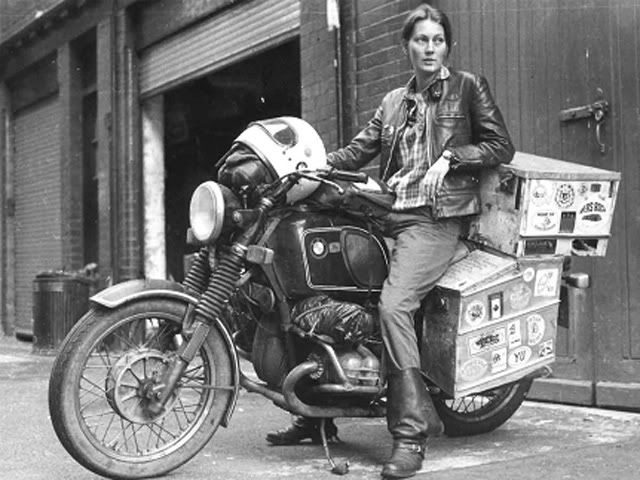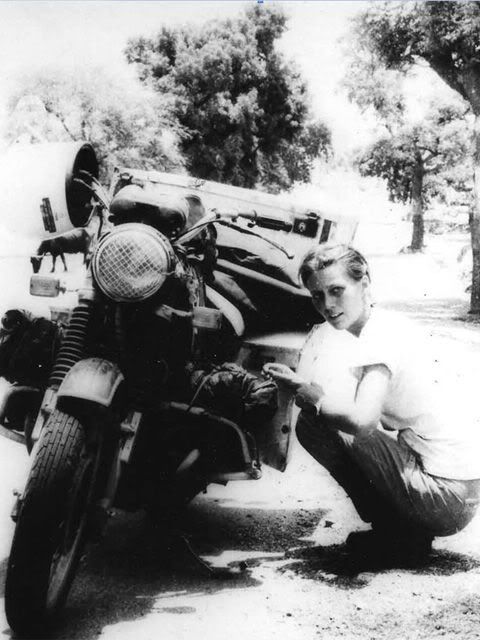New Axe commercial. I am not a huge fan of the recent products of theirs ( the one I liked was discontinued) but thought this commercial film was purty cool and touching.
Thursday, October 2, 2014
Monday, September 29, 2014
Elspeth Beard

 1980,
Elspeth Beard was a 24 years old architect student when she bought an
used BMW -1974 R60/6 to be precise- and decided to ride the world. She
shipped the bike to NY and started the trip, riding up North to Canada,
then down to Mexico before she reached LA. From there, she shipped the
Beemer to Sydney.
1980,
Elspeth Beard was a 24 years old architect student when she bought an
used BMW -1974 R60/6 to be precise- and decided to ride the world. She
shipped the bike to NY and started the trip, riding up North to Canada,
then down to Mexico before she reached LA. From there, she shipped the
Beemer to Sydney.As an architecture student, she did not have enough funding for the complete trip so she had to work while in Australia for 7 month to build up the funding. She wrecked her bike riding Australia and spend 2 weeks in hospital before she finished the trip there.
Her bike was then shipped to Singapore to explore the South-East Asia, where her valuables got stolen. Took 6weeks to replace all the important documents, such as passport, visa for the country she was planning to visit. She wrecked her bike again hitting a tree, destroying a garden of a Thai family, who kindly nursed her for 2 weeks. Her bike was damaged, "I took the cylinder off, straightened the bent studs as best I could and packed the cylinder base with gaskets and goo to get enough compression back".
She rode the India and fell victim to both hepatitis and dysentery. While there, assassination of Mrs. Gandhi (PM of India at the time ) happened, which made her nearly impossible to get out of the country. She got fed up and forged the necessary document to get out. She rode Pakistan then Iran with a fellow BMW rider from Holland but gotten seriously sick from the hepatitis; She had to take some time off at Turkey. After that, she finished the trip through Greece to Europe and finally UK, which was a lot easier ride.
The trip took her 3 years, 48,000 miles and 53 lb of weight loss.
She became the first British woman to circumnavigate the world by motorcycle.
She still rides and helps fellow bike adventurers and has well-established architecture business. Here is Her architecture site
And for more detailed her bike adventure, you can read this an article from Motorcyclist
Monday, September 22, 2014
I want to live in a clean city
It is accused of being staged but still entertaining and I admit I have done the same.
Wednesday, September 3, 2014
Saturday, August 23, 2014
Cars and Films by Jesús Prudencio
Cars And Films is a little project by me, Jesús Prudencio. I love films and cars! I’m a graphic, web designer and illustrator from Badajoz, currently living in Seville, Spain. I have a Bachelor’s Degree of Fine Arts in Graphic Design from the University of Seville. I’ve worked in several studios as Fabulario (a graphic design studio) as co-founder and creative director. Now, I’m a freelance graphic designer.
Saturday, August 2, 2014
Thursday, July 31, 2014
Thursday, July 3, 2014
Art of Late Breaking
Gary Cowan campaigned the 1989 grand prix trail on the Dutch backed Doc shop Yamaha. He returned to Northern Ireland for the annual end of season Sunflower trophy meeting at Kirkistown. Earlier in the day, Gary easily won the 250 race, and he also entered his machine, just a production TZ 250, in the superbike races. The organisers tried to talk him out of it, pointing out that Ron Haslam was bringing the Pepsi RG 500 suzuki, Brian Morrison on the 750 RC Honda,Steve Cull with the super fast rotary Norton, Eddie Laycock aboard his 500 GP Honda ...and more! However, Gary brought the 250 to the line for this, the second superbike race.
Sadly a short five months later, Gary would crash at Daytona, leaving him paralysed from the chest down.
Monday, June 2, 2014
Breaking the Superbike lap record of IOM 132.298 mph
Follow Bruce Anstey on his way to a new Dainese Superbike Race lap record of 132.298mph at the Isle of Man TT 2014.
Tuesday, May 27, 2014
Monday, May 26, 2014
Friday, May 23, 2014
Wednesday, May 21, 2014
Friday, May 9, 2014
Biting Elbows 'Bad Motherfucker' Official Music Video
It is very well shot and entertaining as heck.
Monday, May 5, 2014
Cassoday Ride May/2014
I am not into ride to Cassoday much any longer as it became nothing but a huge motorcycle commercial gathering but I rode with my old friends whom I rode Cassoday with about 5-10 years ago last time. Unlike the last time with them, my bike did not break down and Kirk did not leave me behind.
As for history of Cassoday ride, you can read my previous post about it
It was filled with Harleys and Harley clones. It was not even fun to look around much, as bikes seems to be all the same and alike. But I took pictures of some bikes that caught my eyes.
As for history of Cassoday ride, you can read my previous post about it
It was filled with Harleys and Harley clones. It was not even fun to look around much, as bikes seems to be all the same and alike. But I took pictures of some bikes that caught my eyes.
 |
| Met up at Go Away Garage early morning. |
 |
| airhead Beemer |
 |
| Fully loaded very clean CBX |
 |
| CBX with appeared to be OEM cowling and saddle bags. Never seen those before. |
 |
| VFR750. You don't see those around much. |
 |
| Shovel head |
 |
| Guzzi Quota. I have never seen one in real. |
 |
| A military vehicle was parked in front of Fire dept. |
 |
| bunch of cruiser bikes that I don't care to look at. |
 |
| a line for a food vender. There is no Healthy food |
 |
| Nicely restored Indian |
 |
| Nice vintage Jawa |
 |
| Yamaha XS1100 Turbo |
 |
| Yamaha XS1100 Turbo detail |
 |
| I have never seen Rocket in person either. |
 |
| Triumph Rocket sidecar |
 |
| There was an archery park, where we took break. |
Saturday, May 3, 2014
Thursday, April 24, 2014
Onboard with Ryuichi Kiyonari for Brands Hatch race one
"Onboard with Buildbase BMW's Ryuichi Kiyonari for the opening MCE British Superbike Championship race of the 2014 season at Brands Hatch."
Japanese Rider Ryuichi Kiyonari screws up the start but he comes back
Friday, April 18, 2014
This is your brain on motorcycling
Riding a motorcycle every day might actually keep your brain functioning at peak condition, or so says a study conducted by the University of Tokyo. The study demonstrated that riders between the age of 40 and 50 were shown to improve their levels of cognitive functioning, compared to a control group, after riding their motorcycles daily to their workplace for a mere two months.
Scientists believe that the extra concentration needed to successfully operate a motorcycle can contribute to higher general levels of brain function, and it’s that increase in activity that’s surely a contributing factor to the appeal of the motorcycles as transportation. It’s the way a ride on a bike turns the simplest journey into a challenge to the senses that sets the motorcyclist apart from the everyday commuter. While the typical car-owning motorist is just transporting him or her self from point A to point B, the motorcyclist is actually transported into an entirely different state of consciousness .
Riding a motorcycle is all about entrance into an exclusive club where the journey actually is the destination.
Dr Ryuta Kawashima, author of Dr Kawashima’s Brain Training: How Old Is Your Brain, reported the outcome of his study of “The relationship between motorcycle riding and the human mind.”
Kawashima’s experiments involved current riders who currently rode motorcycles on a regular basis (the average age of the riders was 45) and ex-riders who once rode regularly but had not taken a ride for 10 years or more. Kawashima asked the participants to ride on courses in different conditions while he recorded their brain activities. The eight courses included a series of curves, poor road conditions, steep hills, hair-pin turns and a variety of other challenges.
What did he find? After an analysis of the data, Kawashima found that the current riders and ex-riders used their brain in radically different ways. When the current riders rode motorcycles, specific segments of their brains (the right hemisphere of the prefrontal lobe) was activated and riders demonstrated a higher level of concentration.
His next experiment was a test of how making a habit of riding a motorcycle affects the brain.
Trial subjects were otherwise healthy people who had not ridden for 10 years or more. Over the course of a couple of months, those riders used a motorcycle for their daily commute and in other everyday situations while Dr Kawashima and his team studied how their brains and mental health changed.
The upshot was that the use of motorcycles in everyday life improved cognitive faculties, particularly those that relate to memory and spatial reasoning capacity. An added benefit? Participants revealed on questionnaires they filled out at the end of the study that their stress levels had been reduced and their mental state changed for the better.
So why motorcycles? Shouldn’t driving a car should have the same effect as riding a motorcycle?
“There were many studies done on driving cars in the past,” Kawashima said. “A car is a comfortable machine which does not activate our brains. It only happens when going across a railway crossing or when a person jumps in front of us. By using motorcycles more in our life, we can have positive effects on our brains and minds”.
Yamaha participated in a second joint research project on the subject of the relationship between motorcycle riding and brain stimulation with Kawashima Laboratory at the Department of Functional Brain Imaging, Institute of Development, Aging and Cancer at Tohoku University.
The project began in September 2009 and ran until December 2010, and the focus of the research was on measurement and analysis of the cause and effect relationship involved in the operation of various types of vehicles and brain stimulation. The study measured changes in such stimulation over time by means of data gathered from a long-term mass survey.
The reason for Yamaha Motor’s participation in this project is pretty obvious and not a little self-serving, but further research into the relationship between motorcycle riding and brain stimulation as it relates to the “Smart Aging Society” will certainly provide some interesting results.
The second research project was divided into two time periods throughout 2009 and 2010 compared differences in the conditions of brain stimulation as they related to the type of vehicle and driving conditions. A second set of tests measuring the changes in brain stimulation over time involved a larger subject group.
Yamaha Motors provided vehicles for the research and made its test tracks and courses available for the study. What the study revealed is that what you’re thinking about while you’re riding – and your experience on the bike - changes the physical structure of your brain.
Author Sharon Begley concurs with Kawashima’s findings. In her tome, Train Your Mind – Change Your Brain, Begley found much the same outcomes.
“The brain devotes more cortical real estate to functions that its owner uses more frequently and shrinks the space devoted to activities rarely performed,” Begley wrote. “That’s why the brains of violinists devote more space to the region that controls the digits of the fingering hand.”
And you may also get some mental and physical benefits from just thinking about going for a ride on your machine.
A 1996 experiment at Harvard Medical School by neuroscientist Alvaro Pascual-Leone had volunteers practice a simple five finger exercise on the piano over five days for a couple of hours each day. Pascual-Leone found that the brain space devoted to these finger movements grew and pushed aside areas less used. A separate group of volunteers were asked to simply think about doing the piano exercises during that week as well, and they dedicated the same amount of “practice time.”
Pascual-Leone was somewhat take aback to discover that the region of the brain which controls piano playing finger movement expanded in the same way for volunteers who merely imagined playing the piano.
Along with the obvious benefits of riding motorcycles; like saving money (motorcycle insurance is relatively inexpensive), motorcycles take the edge off the grind of the daily commute, and that appears to make your brain a better place to be…
Via Krtong.com
Subscribe to:
Posts (Atom)






























